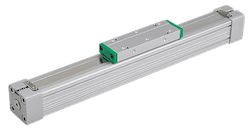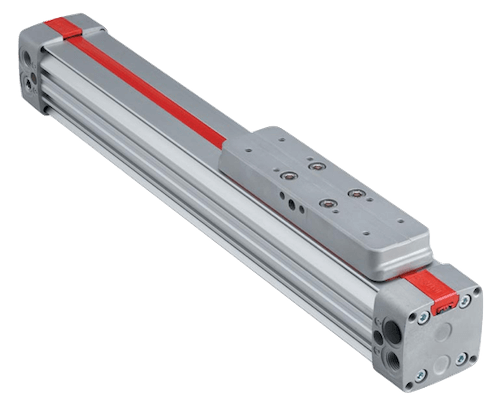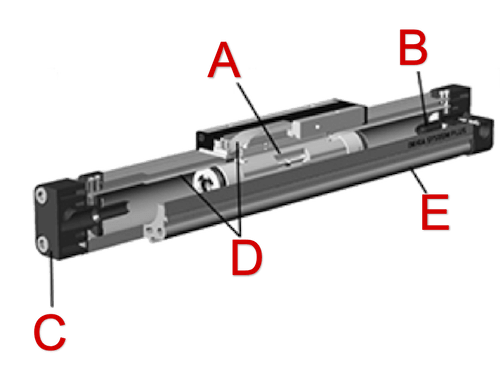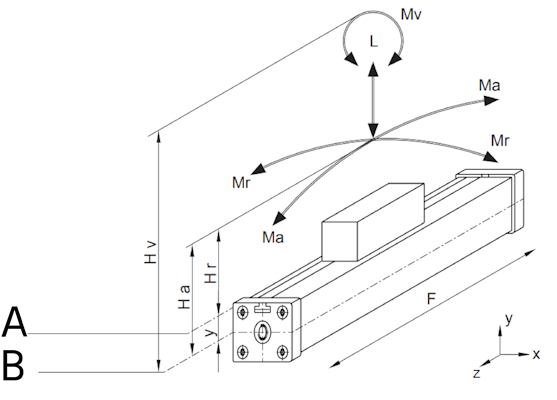
Figure 1: Rodless cylinders
Rodless Cylinder
A rodless cylinder is a pneumatic component capable of moving a load in a linear path with compressed air. A traditional pneumatic cylinder uses a rod to push or pull the load from the piston, whereas a rodless cylinder moves the load alongside the piston. This gives the main advantages of having the same stroke length in less space, no rod buckling to worry about with high loads or long strokes, and it delivers the same force in both directions. The rodless cylinder is most commonly used for applications like material handling, loading, lifting, web cutting, etc. Figure 1 shows an example of a rodless cylinder.
Order your custom rodless cylinder here!
Table of contents
- Rodless cylinder types
- How does a rodless air cylinder work?
- Load consideration
- Advantages / disadvantages of a rodless cylinder
- Accessories
- Applications
- Selection criteria
- FAQs
Rodless cylinder types
There are three main rodless cylinder types, which all refer to how the piston is connected to the carrier to allow movement of the load.
- Magnetic: There is a magnetic connection between the piston and carrier. This allows for a leak-free cylinder. However, you have to worry about de-coupling and carrier rotation.
- Cable: There is a cable connected to the piston and through a pulley on each end then connects to the carrier. This is a very simple design, however, cable wear causes inconsistent positioning and leaks can occur from stretched cables.
- Slotted: There is slot in the cylinder’s length with an inner and outer metal band (Figure 2 red portion) to prevent any leakage. This gives the carrier a direct mechanical connection to the piston. This allows them to be the most versatile and widely used, so we will be discussing this design in this article and it can be seen in Figure 2.

Figure 2: A rodless cylinder with a slotted design and red bands
How does a rodless air cylinder work?
The main components of a rodless cylinder can be seen in Figure 3. An internal piston (A) moves within the cylinder barrel (E) and is driven by compressed air. Depending on the air pressure on each port, the piston moves in either direction along the length of the cylinder. The piston is attached to a carrier. This carrier supports the mounted load and moves with the piston. The metal bands (D) allow the carrier to move back and forth while creating a reliable sealing of the cylinder slot. Under the carrier, the bands are bended away from the slot to allow a connection between piston and carrier. There are adjustable end-cushioning on both ends (B) to prevent any hard stops after full travel length at the end caps (C). Figure 4 shows a slotted rodless cylinder design and how the mechanical connection is made through the bands.

Figure 3: Components of a rodless cylinder: aluminum piston with integrated magnets (A), adjustable end-cushioning on both ends (B), end caps (C), corrosion resistant steel outer and inner band (D), and the cylinder barrel (E)

Figure 4: A slotted rodless cylinder piston
Load consideration
Properly understanding how loads affect a rodless cylinder ensures proper function. With different weights, weight location, and speed, a moment can be formed that needs to be accounted for. A moment is a force that causes a body to rotate around a specific point or axis. Figure 5 shows the three moments to consider (discussed below) along with formulas on how to calculate them. We can then use this calculated moment force to the rodless cylinder’s published bending moments (typically they list the maximum) to ensure our forces are under this limit.
- Pitch (Ma): Can handle these moments well, and even better the longer the carrier is. The acceleration and deceleration force affect this moment.
- Roll (Mr): Very sensitive to these moments. An off-centered load can cause these moments.
- Yaw (Mv): Somewhat sensitive to these moments, but are less common.
The moment can be calculated as shown below. Compare your calculated values with the maximum values in the cylinders datasheet.
- Moment: Force x Distance
- Force: Typically just the load’s weight
- Distance: Distance from the center of mass of the load to the center of mass of the carrier.

Figure 5: An example on how a moment is created and calculated: guiding axle (A) and piston axle (B).
Acceleration & deceleration
Unlike a normal pneumatic cylinder with a rod, a rodless cylinder must support the resulting moments from acceleration and deceleration. Imagine this as a “jerk”, which is the same force you feel when you accelerate/slow down in a car you jerk back/forward in the car due to the moment of force. The force in these equations is equal to the mass multiplied by the acceleration (or deceleration). If it is a deceleration force, you need to consider the adjustable cushioning at the end of the stroke length. Additional forces can also affect the total force in either direction, like friction and breakaway forces.
Vertical mounting
Vertical applications have two additional important considerations regarding the load. First, you have to fight against gravity (or with gravity) when moving the load and holding the load. Additionally, if you are holding the load, you need to ensure that the pneumatic cylinder does not leak air and that the air supply is constant to prevent any movement once in position due to gravity.
Additional components
A rodless cylinder requires the following pneumatic systems/components for effective operation:
- Pneumatic air supply: To supply clean and compressed air that drives the rodless cylinder.
- Pneumatic solenoid valve: To control the flow of compressed air.
- Pneumatic hose: To supply compressed air to ports, valves and other devices.
Advantages / disadvantages of a rodless cylinder
Rodless cylinder differ from conventional cylinders and provide many advantages in comparison.
- Smaller footprint for similar stroke length making them ideal for applications with limited space.
- Ability to better support high loads and moment forces.
- With no rod, they eliminate the risk of rod bending and buckling.
- Same force in both directions.
Rodless cylinders also have few disadvantages:
- Vulnerable to environmental dust and debris.
- Load movement is fixed to the length of the cylinder.
- Inner and outer bands may wear overtime as they stretch.
- Air leaks due to band wear can result in loss of air pressure.
Accessories
Following are the most commonly used accessories with rodless cylinders:
- Foot mounting: Provides support to the cylinder and prevents it from pivoting back and forth.
- Center mounting: Provides support for long stroke cylinders by absorbing the force along the centerline and distributing it evenly through the cylinder.
- Limit switch: Detects the proximity of the carrier/load or end positions, thus preventing further movement.
- Carrier: Provides support by supporting and moving the load along the length of the cylinder.
Applications
Rodless cylinders, due to its many advantages are used in various industries. Some common applications include:
- Automotive
- Manufacturing
- Robotics
- Food and beverage
- Packaging
- Commercial sewing
- Warehouse lifting
- Printing
- Spray painting
- Tire fabrication
- Optical sorting
Selection criteria
The following criteria should be considered while selecting a rodless cylinder:
- Stroke speed: This is the speed at which the piston moves within the cylinder. This would depend upon the air pressure supplied at each port and the load.
- Carrier Load: The carrier must be able to support and move the mounted load safely and efficiently.
- Dead length: It is the length of cylinder that cannot be used due to internal components and room required for end-of-stroke. This is required to determine the working cylinder length required for application.
- Cylinder length: This is the actual working stroke distance, which is the distance that the load will travel.
- Air pressure: As the piston is driven my compressed air, there must availability of constant air pressure throughout the application.
- Bore Size: Bore size can be chosen according to the capacity range required for the application. For a cylinder to perform at maximum capacity, larger bore size should be considered.
FAQs
How does a rodless cylinder work?
A rodless cylinder consists of an internal piston which moves within the cylinder driven by compressed air. The piston is attached to a carrier, which supports the load and moves it in a linear direction with the piston.
How do you calculate air cylinder force?
The force exerted in the cylinder is the product of air pressure applied and usable piston area.





